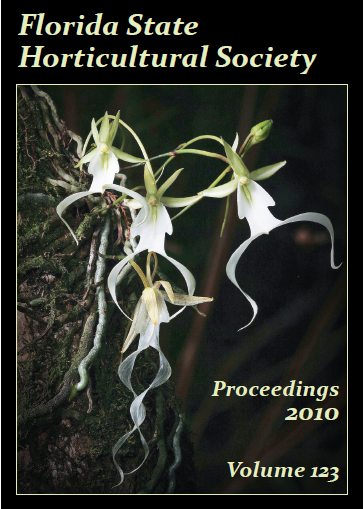Handling & Processing
Published 2010-12-01
Keywords
- polysaccharide,
- homogalacturonan,
- degree of esterification,
- pectinesterase,
- pectin methylesterase
Abstract
After removal of soluble sugars and other compounds by washing, citrus peel is largely composed of pectin, cellulose, and hemicelluloses. One of the major components, pectin can be modified using pectinesterases, which reduce the degree of methylation (DM). Low DM pectins have great utility in the food industry and other applications. They have been shown to have calcium sensitivity, which is an important functional property of pectins for use in applications which require suspension, metal ion binding or water absorption. Thus, an estimate of DM is an important parameter to determine but most DM analyses are difficult to perform. A new method has been developed based on contactless conductivity. The conductivity, as measured by a contactless conductivity meter, increases with decreasing DM, with values ranging from 94.0 to zero when pectins are analyzed on size exclusion chromatography columns (SEC) with concentration of pectin measured with interferometric refractive index detector (RI). Data fit to a linear equation, of DM to conductivity detector response, yields y = –5.96 × 10–3x + 0.592 with an r2 value of 0.998. These results demonstrate that DM and molecular weight can be measured simultaneously on SEC using contactless conductivity.References
- Blumenkrantz, N., and G. Asboe Hansen. 1973. New method for quantitative determination of uronic acids. Anal. Biochemistry 54(2):484–489.
- Codex. 1981. Food chemical codex 3rd ed. Natl. Acad. Sci., Washington, DC.
- Gas, B., M. Demjanenko, and J. Vacík. 1980. High-frequency contactless conductivity detection in isotachophoresis. J. Chromatography A 192(2):253-257.
- Klavons, J. and R. Bennett. 1986. Determination of methanol using alcohol oxidase and its application to methyl ester content of pectins. J. Agr. Food Chem. 34:597–599.
- Kubán, P. and P.C. Hauser. 2009. Ten years of axial capacitively coupled contactless conductivity detection for CZE—A review. Electrophoresis 30(1):176–188.
- Levigne, S., M. Thomas, M.C. Ralet, B. Quemener, and J.F. Thibault. 2002. Determination of the degrees of methylation and acetylation of pectins using a C18 column and internal standards. Food Hydrocolloids 16(6):547–550.
- Luzio, G.A. 2004. Determination of galacturonic acid content of pectin using a microtiter plate assay. Proc. Fla. State Hort. Soc. 117:416–421.
- Ploger, A. 1992. Conductivity detection of pectin: A rapid HPLC method to analyze degree of esterification. J. Food Sci. 57(5):1185–1186.
- Powell, D.A., E.R. Morris, M.J. Gidley, and D.A. Rees. 1982. Conformations and interactions of pectins. II. Influences of residue sequence on chain association in calcium pectate gels. J. Mol. Biol. 155(4):517–531.
- Recape, E., J.F. Thibault, J.C.E. Reitsma, and W. Pilnik. 1989. Properties of admidated pectins. II. Polyelectrolye behavior and calcium binding of amidated pectins and amidated pectic acids. Biopolymers 28:1435–1448.
- Ridley, B.L., M.A. O’Neill, and D. Mohnen. 2001. Pectins: Structure, biosynthesis, and oligogalacturonide-related signaling. Phytochemistry 57(6):929–967.
- Thibault, J.F. and M. Rinaudo. 1985. Interactions of mono- and divalent counterions with alkali- and enzyme-deesterified pectins in salt-free solutions. Biopolymers 24(11):2131–2143.
- Vincken, J.-P., H.A. Schols, R.J.F.J. Oomen, M.C. McCann, P. Ulvskov, A.G.J. Voragen, and R.G.F. Visser. 2003. If homogalacturonan were a side chain of rhamnogalacturonan. I. Implications for cell wall architecture. Plant Physiol. 132(4):1781–1789.
- Willats, W.G., C. Orfila, G. Limberg, H.C. Buchholt, G.J. van Alebeek, A.G. Voragen, S.E. Marcus, T.M. Christensen, J. Mikkelsen, B.S. Murray, and J.P. Knox. 2001. Modulation of the degree and pattern of methyl-esterification of pectic homogalacturonan in plant cell walls. Implications for pectin methyl esterase action, matrix properties, and cell adhesion. J. Biological Chem. 276(22):19404–13.
- Zemann, A.J., E. Schnell, D. Volgger, and G.K. Bonn. 1998. Contactless conductivity detection for capillary electrophoresis. Anal. Chem. 70(3):563–567.

